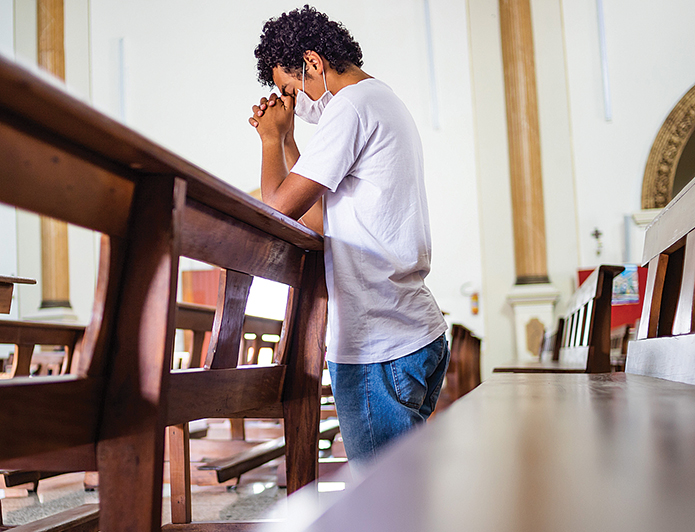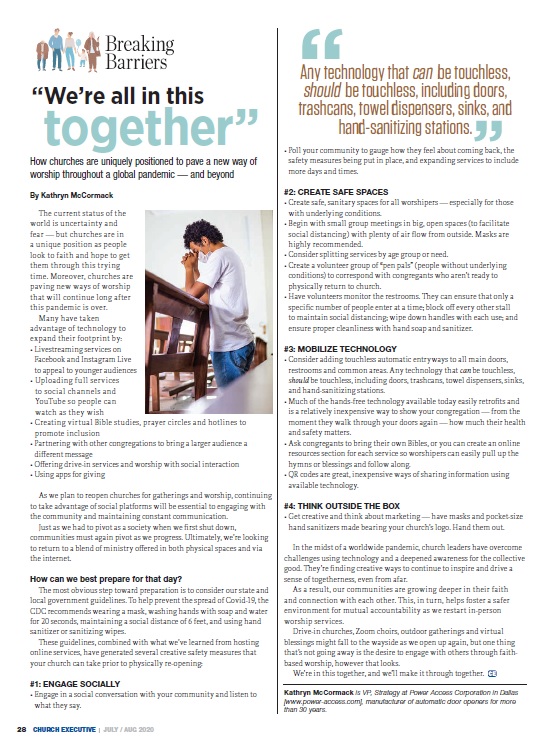
How churches are uniquely positioned to pave a new way of worship throughout a global pandemic — and beyond
By Kathryn McCormack
 The current status of the world is uncertainty and fear — but churches are in a unique position as people look to faith and hope to get them through this trying time. Moreover, churches are paving new ways of worship that will continue long after this pandemic is over.
The current status of the world is uncertainty and fear — but churches are in a unique position as people look to faith and hope to get them through this trying time. Moreover, churches are paving new ways of worship that will continue long after this pandemic is over.
Many have taken advantage of technology to expand their footprint by:
- Livestreaming services on Facebook and Instagram Live to appeal to younger audiences
- Uploading full services to social channels and YouTube so people can watch as they wish
- Creating virtual Bible studies, prayer circles and hotlines to promote inclusion
- Partnering with other congregations to bring a larger audience a different message
- Offering drive-in services and worship with social interaction
- Using apps for giving
As we plan to reopen churches for gatherings and worship, continuing to take advantage of social platforms will be essential to engaging with the community and maintaining constant communication.
Just as we had to pivot as a society when we first shut down, communities must again pivot as we progress. Ultimately, we’re looking to return to a blend of ministry offered in both physical spaces and via the internet.
How can we best prepare for that day?
The most obvious step toward preparation is to consider our state and local government guidelines. To help prevent the spread of Covid-19, the CDC recommends wearing a mask, washing hands with soap and water for 20 seconds, maintaining a social distance of 6 feet, and using hand sanitizer or sanitizing wipes.
These guidelines, combined with what we’ve learned from hosting online services, have generated several creative safety measures that your church can take prior to physically re-opening:
#1: ENGAGE SOCIALLY
- Engage in a social conversation with your community and listen to what they say.
- Poll your community to gauge how they feel about coming back, the safety measures being put in place, and expanding services to include more days and times.
#2: CREATE SAFE SPACES
- Create safe, sanitary spaces for all worshipers — especially for those with underlying conditions.
- Begin with small group meetings in big, open spaces (to facilitate social distancing) with plenty of air flow from outside. Masks are highly recommended.
- Consider splitting services by age group or need.
- Create a volunteer group of “pen pals” (people without underlying conditions) to correspond with congregants who aren’t ready to physically return to church.
- Have volunteers monitor the restrooms. They can ensure that only a specific number of people enter at a time; block off every other stall to maintain social distancing; wipe down handles with each use; and ensure proper cleanliness with hand soap and sanitizer.

#3: MOBILIZE TECHNOLOGY
- Consider adding touchless automatic entryways to all main doors, restrooms and common areas. Any technology that can be touchless, should be touchless, including doors, trashcans, towel dispensers, sinks, and hand-sanitizing stations.
- Much of the hands-free technology available today easily retrofits and is a relatively inexpensive way to show your congregation — from the moment they walk through your doors again — how much their health and safety matters.
- Ask congregants to bring their own Bibles, or you can create an online resources section for each service so worshipers can easily pull up the hymns or blessings and follow along.
- QR codes are great, inexpensive ways of sharing information using available technology.
#4: THINK OUTSIDE THE BOX
- Get creative and think about marketing — have masks and pocket-size hand sanitizers made bearing your church’s logo. Hand them out.
In the midst of a worldwide pandemic, church leaders have overcome challenges using technology and a deepened awareness for the collective good. They’re finding creative ways to continue to inspire and drive a sense of togetherness, even from afar.
As a result, our communities are growing deeper in their faith and connection with each other. This, in turn, helps foster a safer environment for mutual accountability as we restart in-person worship services.
Drive-in churches, Zoom choirs, outdoor gatherings and virtual blessings might fall to the wayside as we open up again, but one thing that’s not going away is the desire to engage with others through faith-based worship, however that looks.
We’re in this together, and we’ll make it through together.
Kathryn McCormack is VP, Strategy at Power Access Corporation in Dallas, manufacturer of automatic door openers for more than 30 years.


